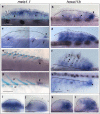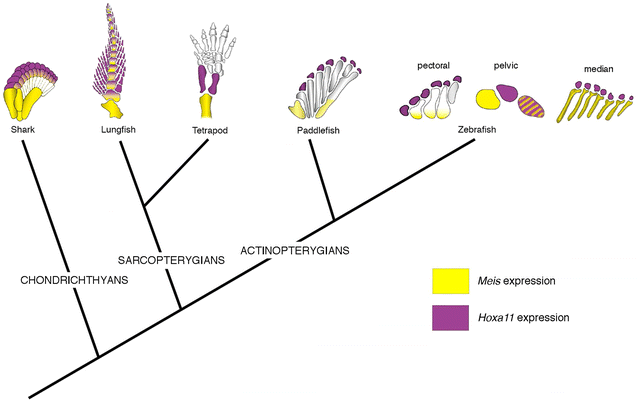Expression of meis and hoxa11 in dipnoan and teleost fins provides new insights into the evolution of vertebrate appendages
- PMID: 29719716
- PMCID: PMC5924435
- DOI: 10.1186/s13227-018-0099-9
Expression of meis and hoxa11 in dipnoan and teleost fins provides new insights into the evolution of vertebrate appendages
Abstract
Background: The concerted activity of Meis and Hoxa11 transcription factors is essential for the subdivision of tetrapod limbs into proximo-distal (PD) domains; however, little is know about the evolution of this patterning mechanism. Here, we aim to study the expression of meis and hoxa11 orthologues in the median and paired rayed fins of zebrafish and in the lobed fins of the Australian lungfish.
Results: First, a late phase of expression of meis1.1 and hoxa11b in zebrafish dorsal and anal fins relates with segmentation of endochondral elements in proximal and distal radials. Second, our zebrafish in situ hybridization results reveal spatial and temporal changes between pectoral and pelvic fins. Third, in situ analysis of meis1, meis3 and hoxa11 genes in Neoceratodus pectoral fins identifies decoupled domains of expression along the PD axis.
Conclusions: Our data raise the possibility that the origin of stylopod and zeugopod lies much deeper in gnathostome evolution and that variation in meis and hoxa11 expression has played a substantial role in the transformation of appendage anatomy. Moreover, these observations provide evidence that the Meis/Hoxa11 profile considered a hallmark of stylopod/zeugopod patterning is present in Neoceratodus.
Keywords: Fin-to-limb transition; Gene expression; Hoxa11; Meis; Neoceratodus; Zebrafish.
Figures




References
-
- Shubin N. The evolution of paired fins and the origin of tetrapod limbs–Phylogenetic and transformational approaches. Evol Biol. 1995;28:39–86.
-
- Coates MI, Ruta M. Skeletal changes in the transition from fins to limbs. In: Hall BK, editor. Fins to limbs: evolution, development, and transformation. Chicago: University of Chicago; 2007. pp. 15–38.
LinkOut - more resources
Full Text Sources
Other Literature Sources
Molecular Biology Databases

